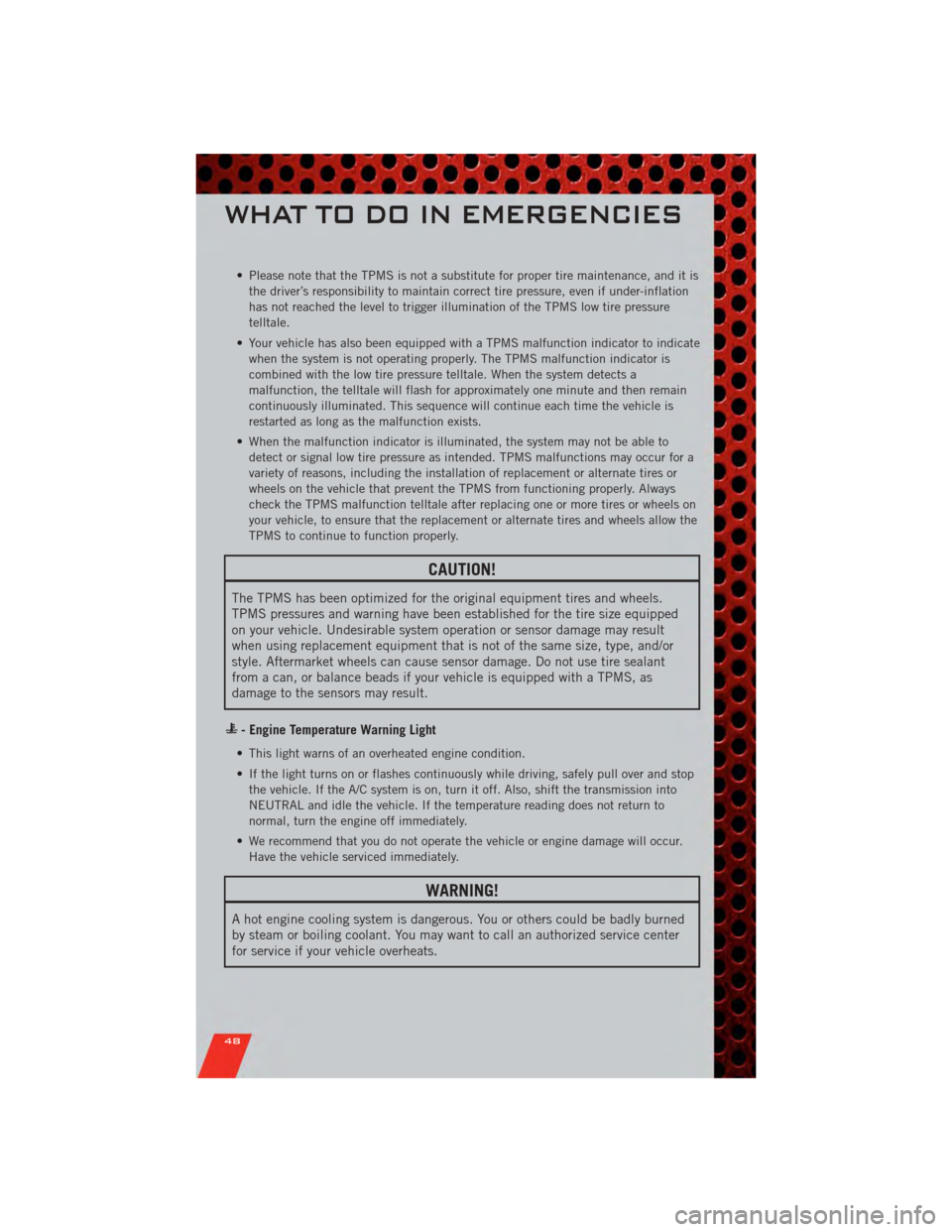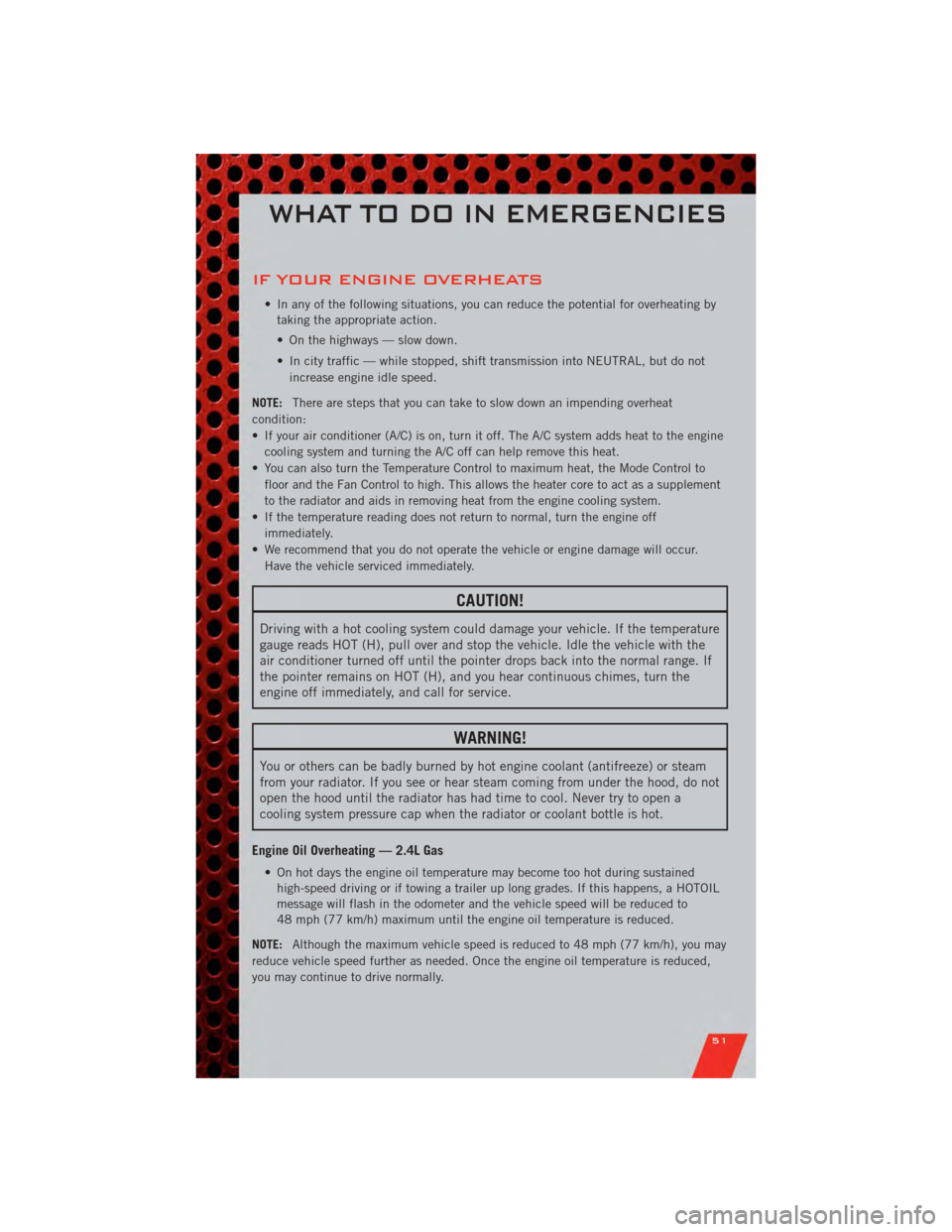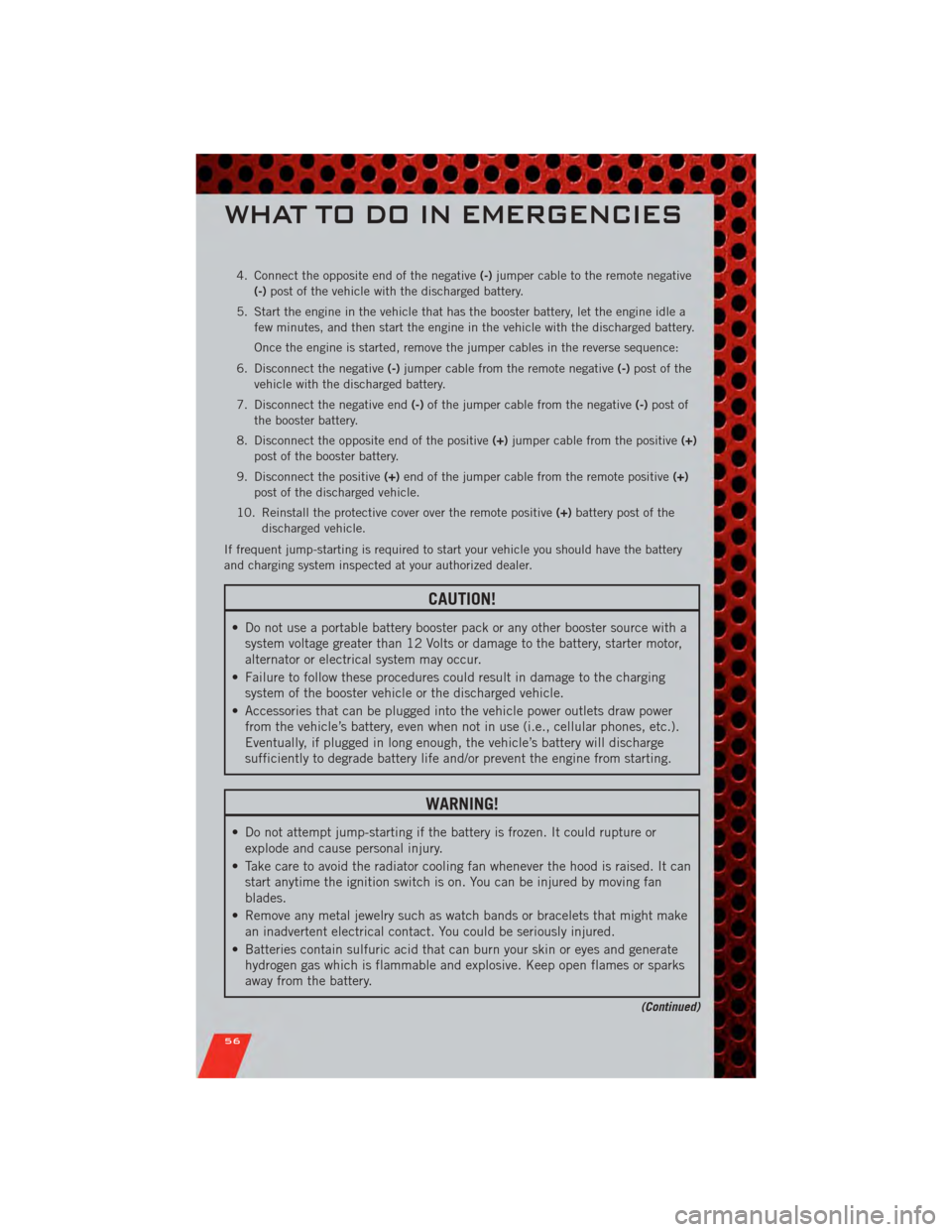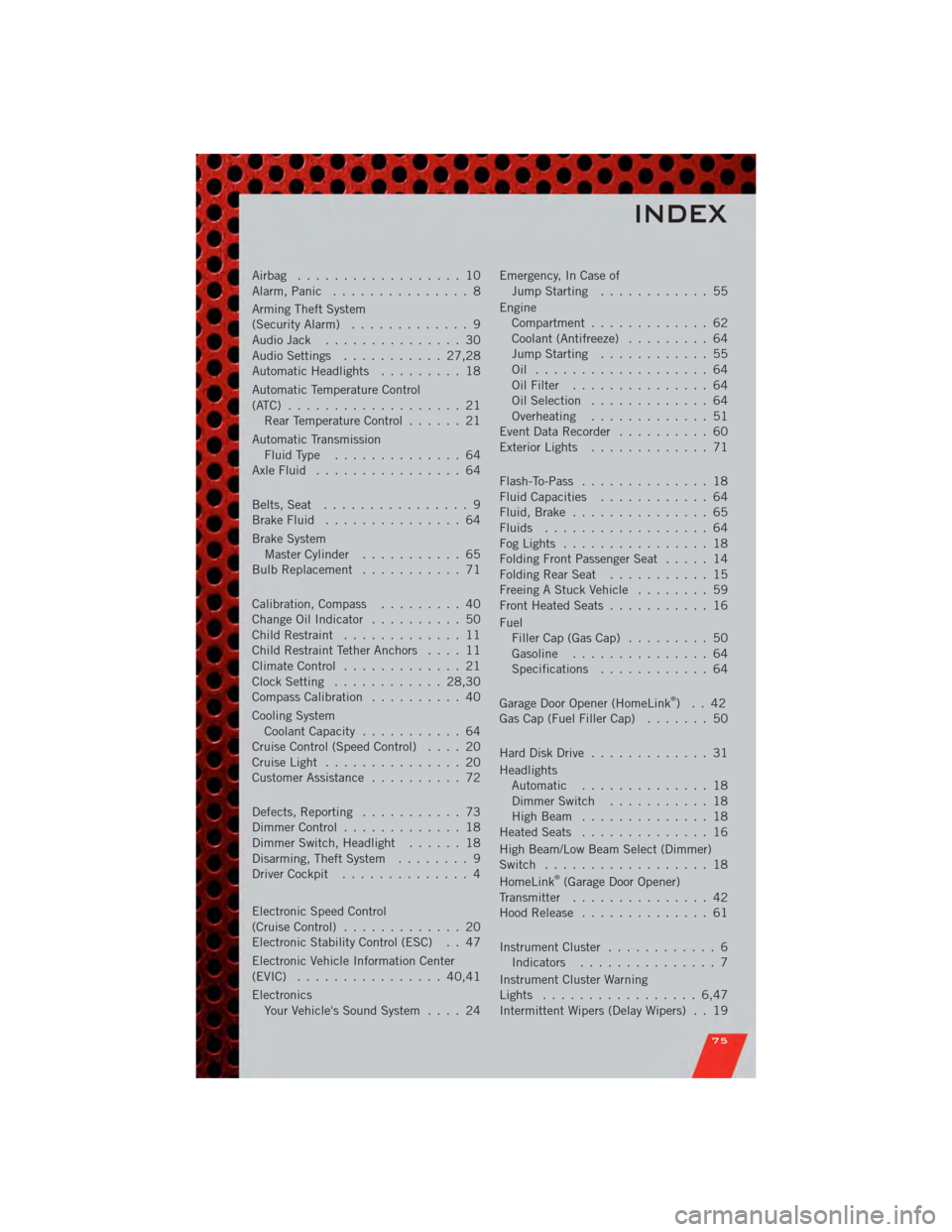cooling DODGE AVENGER 2011 2.G User Guide
[x] Cancel search | Manufacturer: DODGE, Model Year: 2011, Model line: AVENGER, Model: DODGE AVENGER 2011 2.GPages: 84, PDF Size: 3.81 MB
Page 50 of 84

• Please note that the TPMS is not a substitute for proper tire maintenance, and it isthe driver’s responsibility to maintain correct tire pressure, even if under-inflation
has not reached the level to trigger illumination of the TPMS low tire pressure
telltale.
• Your vehicle has also been equipped with a TPMS malfunction indicator to indicate when the system is not operating properly. The TPMS malfunction indicator is
combined with the low tire pressure telltale. When the system detects a
malfunction, the telltale will flash for approximately one minute and then remain
continuously illuminated. This sequence will continue each time the vehicle is
restarted as long as the malfunction exists.
• When the malfunction indicator is illuminated, the system may not be able to detect or signal low tire pressure as intended. TPMS malfunctions may occur for a
variety of reasons, including the installation of replacement or alternate tires or
wheels on the vehicle that prevent the TPMS from functioning properly. Always
check the TPMS malfunction telltale after replacing one or more tires or wheels on
your vehicle, to ensure that the replacement or alternate tires and wheels allow the
TPMS to continue to function properly.
CAUTION!
The TPMS has been optimized for the original equipment tires and wheels.
TPMS pressures and warning have been established for the tire size equipped
on your vehicle. Undesirable system operation or sensor damage may result
when using replacement equipment that is not of the same size, type, and/or
style. Aftermarket wheels can cause sensor damage. Do not use tire sealant
from a can, or balance beads if your vehicle is equipped with a TPMS, as
damage to the sensors may result.
- Engine Temperature Warning Light
• This light warns of an overheated engine condition.
• If the light turns on or flashes continuously while driving, safely pull over and stopthe vehicle. If the A/C system is on, turn it off. Also, shift the transmission into
NEUTRAL and idle the vehicle. If the temperature reading does not return to
normal, turn the engine off immediately.
• We recommend that you do not operate the vehicle or engine damage will occur. Have the vehicle serviced immediately.
WARNING!
A hot engine cooling system is dangerous. You or others could be badly burned
by steam or boiling coolant. You may want to call an authorized service center
for service if your vehicle overheats.
WHAT TO DO IN EMERGENCIES
48
Page 53 of 84

IF YOUR ENGINE OVERHEATS
• In any of the following situations, you can reduce the potential for overheating bytaking the appropriate action.
• On the highways — slow down.
• In city traffic — while stopped, shift transmission into NEUTRAL, but do not
increase engine idle speed.
NOTE: There are steps that you can take to slow down an impending overheat
condition:
• If your air conditioner (A/C) is on, turn it off. The A/C system adds heat to the engine cooling system and turning the A/C off can help remove this heat.
• You can also turn the Temperature Control to maximum heat, the Mode Control to floor and the Fan Control to high. This allows the heater core to act as a supplement
to the radiator and aids in removing heat from the engine cooling system.
• If the temperature reading does not return to normal, turn the engine off immediately.
• We recommend that you do not operate the vehicle or engine damage will occur. Have the vehicle serviced immediately.
CAUTION!
Driving with a hot cooling system could damage your vehicle. If the temperature
gauge reads HOT (H), pull over and stop the vehicle. Idle the vehicle with the
air conditioner turned off until the pointer drops back into the normal range. If
the pointer remains on HOT (H), and you hear continuous chimes, turn the
engine off immediately, and call for service.
WARNING!
You or others can be badly burned by hot engine coolant (antifreeze) or steam
from your radiator. If you see or hear steam coming from under the hood, do not
open the hood until the radiator has had time to cool. Never try to open a
cooling system pressure cap when the radiator or coolant bottle is hot.
Engine Oil Overheating — 2.4L Gas
• On hot days the engine oil temperature may become too hot during sustained high-speed driving or if towing a trailer up long grades. If this happens, a HOTOIL
message will flash in the odometer and the vehicle speed will be reduced to
48 mph (77 km/h) maximum until the engine oil temperature is reduced.
NOTE: Although the maximum vehicle speed is reduced to 48 mph (77 km/h), you may
reduce vehicle speed further as needed. Once the engine oil temperature is reduced,
you may continue to drive normally.
WHAT TO DO IN EMERGENCIES
51
Page 58 of 84

4. Connect the opposite end of the negative(-)jumper cable to the remote negative
(-) post of the vehicle with the discharged battery.
5. Start the engine in the vehicle that has the booster battery, let the engine idle a few minutes, and then start the engine in the vehicle with the discharged battery.
Once the engine is started, remove the jumper cables in the reverse sequence:
6. Disconnect the negative (-)jumper cable from the remote negative (-)post of the
vehicle with the discharged battery.
7. Disconnect the negative end (-)of the jumper cable from the negative (-)post of
the booster battery.
8. Disconnect the opposite end of the positive (+)jumper cable from the positive (+)
post of the booster battery.
9. Disconnect the positive (+)end of the jumper cable from the remote positive (+)
post of the discharged vehicle.
10. Reinstall the protective cover over the remote positive (+)battery post of the
discharged vehicle.
If frequent jump-starting is required to start your vehicle you should have the battery
and charging system inspected at your authorized dealer.
CAUTION!
• Do not use a portable battery booster pack or any other booster source with a system voltage greater than 12 Volts or damage to the battery, starter motor,
alternator or electrical system may occur.
• Failure to follow these procedures could result in damage to the charging system of the booster vehicle or the discharged vehicle.
• Accessories that can be plugged into the vehicle power outlets draw power from the vehicle’s battery, even when not in use (i.e., cellular phones, etc.).
Eventually, if plugged in long enough, the vehicle’s battery will discharge
sufficiently to degrade battery life and/or prevent the engine from starting.
WARNING!
• Do not attempt jump-starting if the battery is frozen. It could rupture orexplode and cause personal injury.
• Take care to avoid the radiator cooling fan whenever the hood is raised. It can start anytime the ignition switch is on. You can be injured by moving fan
blades.
• Remove any metal jewelry such as watch bands or bracelets that might make an inadvertent electrical contact. You could be seriously injured.
• Batteries contain sulfuric acid that can burn your skin or eyes and generate hydrogen gas which is flammable and explosive. Keep open flames or sparks
away from the battery.
(Continued)
WHAT TO DO IN EMERGENCIES
56
Page 77 of 84

Airbag .................. 10
Alarm,Panic ............... 8
Arming Theft System
(Security Alarm)............. 9
Audio Jack ............... 30
Audio Settings ........... 27,28
Automatic Headlights ......... 18
Automatic Temperature Control
(ATC) ................... 21 Rear Temperature Control ...... 21
Automatic Transmission FluidType .............. 64
AxleFluid ................ 64
Belts, Seat ................ 9
Brake Fluid ............... 64
Brake System Master Cylinder ........... 65
BulbReplacement ........... 71
Calibration,Compass ......... 40
ChangeOilIndicator .......... 50
Child Restraint ............. 11
Child Restraint Tether Anchors .... 11
Climate Control ............. 21
Clock Setting ............ 28,30
Compass Calibration .......... 40
Cooling System Coolant Capacity ........... 64
Cruise Control (Speed Control) .... 20
CruiseLight ............... 20
Customer Assistance .......... 72
Defects, Reporting ........... 73
Dimmer Control ............. 18
Dimmer Switch, Headlight ...... 18
Disarming, Theft System ........ 9
Driver Cockpit .............. 4
Electronic Speed Control
(Cruise Control) ............. 20
Electronic Stability Control (ESC) . . 47
Electronic Vehicle Information Center
(EVIC) ................ 40,41
Electronics Your Vehicle's Sound System .... 24Emergency, In Case of
Jump Starting ............ 55
Engine Compartment ............. 62
Coolant (Antifreeze) ......... 64
Jump Starting ............ 55
Oil ................... 64
Oil Filter ............... 64
Oil Selection ............. 64
Overheating ............. 51
Event Data Recorder .......... 60
Exterior Lights ............. 71
Flash-To-Pass .............. 18
Fluid Capacities ............ 64
Fluid, Brake ............... 65
Fluids .................. 64
FogLights ................ 18
Folding Front Passenger Seat ..... 14
FoldingRearSeat ........... 15
Freeing A Stuck Vehicle ........ 59
Front Heated Seats ........... 16
Fuel Filler Cap (Gas Cap) ......... 50
Gasoline ............... 64
Specifications ............ 64
Garage
Door Opener (HomeLink
®)..42
Gas Cap (Fuel Filler Cap) ....... 50
Hard Disk Drive ............. 31
Headlights Automatic .............. 18
Dimmer Switch ........... 18
HighBeam .............. 18
Heated Seats .............. 16
High Beam/Low Beam Select (Dimmer)
Switch .................. 18
HomeLink
®(Garage Door Opener)
Transmitter ............... 42
Hood Release .............. 61
Instrument Cluster ............ 6
Indicators ............... 7
Instrument Cluster Warning
Lights ................. 6,47
Intermittent Wipers (Delay Wipers) . . 19
INDEX
75